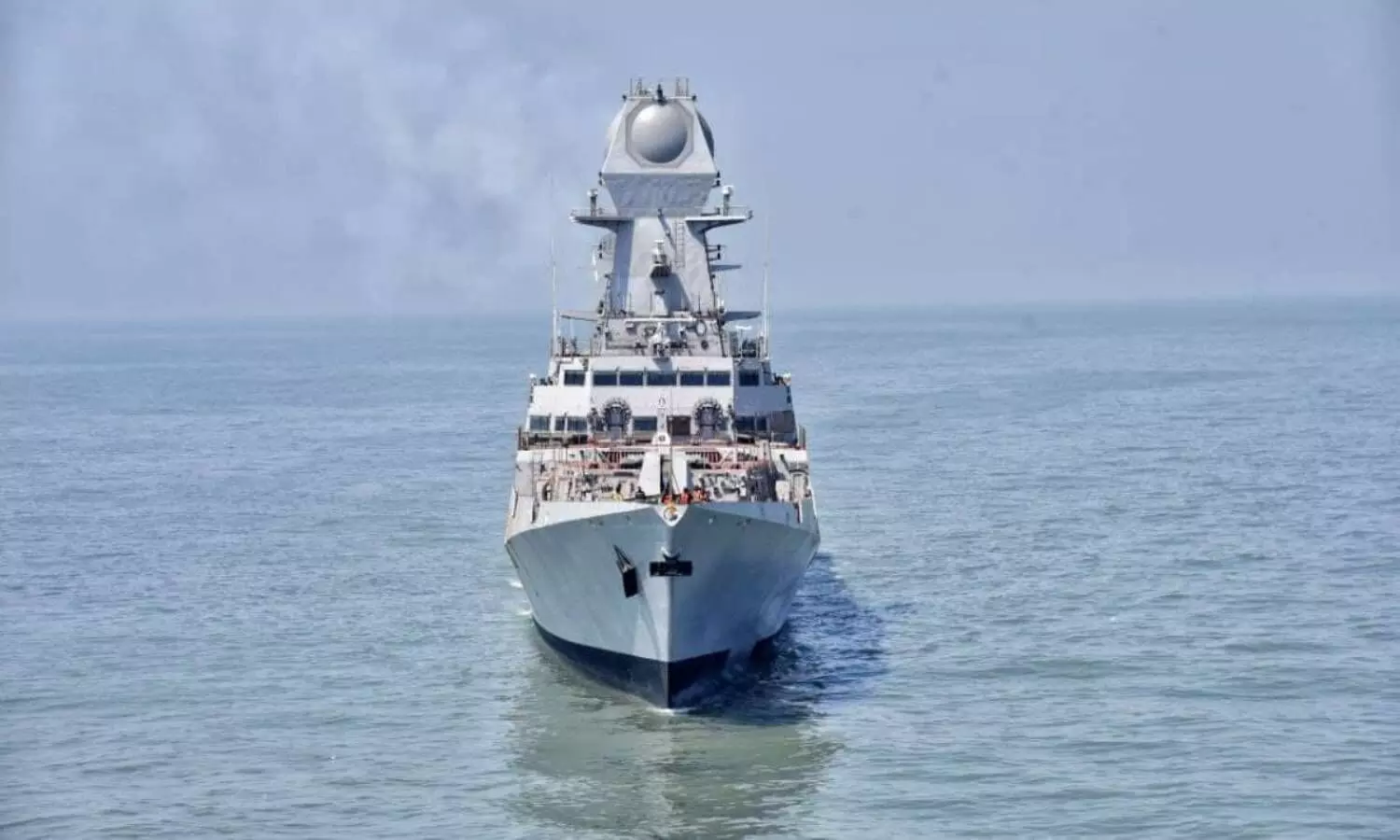INS Visakhapatnam: Indigenously developed P15B stealth guided-missile destroyer commissioned into Indian Navy
INS Visakhapatnam, a P15B stealth guided-missile destroyer, was commissioned into the Indian Navy at the Naval Dockyard, Mumbai on Sunday.
By Newsmeter Network
Visakhapatnam: INS Visakhapatnam, a P15B stealth guided-missile destroyer, was commissioned into the Indian Navy at the Naval Dockyard, Mumbai on Sunday.
The event marks the formal induction of the first of the four 'Visakhapatnam' class destroyers, indigenously designed by the Indian Navy's in-house organization Directorate of Naval Design and constructed by Mazagon Dock Shipbuilders Limited, Mumbai.
Named after the historic city of Andhra Pradesh on the east coast, Visakhapatnam, the 'City of Destiny', the ship has a total complement of about 315 personnel. Enhanced crew comfort is a significant feature of INS Visakhapatnam, which has been ensured through ergonomically designed accommodation based on 'modular' concepts. The ship will be under the command of Captain Birendra Singh Bains, a Navigation & Direction specialist.
INS Visakhapatnam measures 163m in length, 17m in breadth with a displacement of 7,400 tonnes, and can rightfully be regarded as one of the most potent warships to have been constructed in India. The ship is propelled by four powerful Gas Turbines, in a Combined Gas and Gas (COGAG) configuration, capable of achieving speeds in excess of30 knots. The ship has enhanced stealth features resulting in a reduced Radar Cross Section (RCS) achieved through efficient shaping of the hull, full beam superstructure design, plated masts, and use of radar transparent materials on exposed decks.
The ship is packed with sophisticated state-of-the-art weapons and sensors such as Surface-to-Surface missiles and Surface-to-Air missiles. It is fitted with modern surveillance radar which provides target data to the gunnery weapon systems of the ship. The anti-submarine warfare capabilities are provided by the indigenously developed rocket launchers, torpedo launchers, and ASW helicopters. The ship is equipped to fight under Nuclear, Biological, and Chemical (NBC) warfare conditions.
A unique feature of this ship is the high level of indigenization incorporated in the production, accentuating the national objective of 'Aatmanirbhar Bharat'. Some of the major indigenized equipment/systems onboard INS Visakhapatnam include Combat Management System, Rocket Launcher, Torpedo Tube Launcher, Integrated Platform Management System, Automated Power Management System, Foldable Hangar Doors, Helo Traversing system, Close-in Weapon System and the Bow mounted SONAR.
Speaking on the occasion, defence minister Rajnath Singh termed INS Visakhapatnam as a symbol of the growing maritime prowess of the country and a major milestone in achieving Prime Minister Narendra Modi's vision of 'Make in India, Make for the World'.
He said the ship is a reminder of ancient and medieval India's maritime power, shipbuilding skills, and glorious history. Singh exuded confidence that the state-of-the-art ship, equipped with the latest systems and weapons, will strengthen the maritime security and protect the interests of the Nation.
He defined the ship as one of the most technologically advanced guided-missile destroyers in the world which will cater to the present & future requirements of the Armed Forces and the Nation as a whole.
Singh termed the Navy's order of 39 of the 41 ships and submarines from Indian shipyards as a testament to their commitment towards achieving 'Aatmanirbhar Bharat'. He described the development of Indigenous Aircraft Carrier 'INS Vikrant' as an important milestone in their path to achieving 'Aatmanibar Bharat'.
"The carrier will increase our reach from the Indian Ocean to the Pacific and the Atlantic Ocean. Its commissioning will be a golden moment in the history of the Indian Defence. It will be the best occasion to celebrate the 75th anniversary of India's independence and the 50th anniversary of India's victory in the 1971 war," he said.
He praised the Indian Navy's consistent efforts to participate in various outreach programmes of the industries and increase indigenized items under 'Float', 'Move' and 'Fight' categories. Stressing on the need to maintain the momentum, he expressed confidence that "the steps taken by the government will continue to provide a boost to the self-reliance efforts and we will soon build ships not just for India, but for the entire world". He assured of Government's continuous support to achieve this vision.
Singh exhorted the public & private sector to take advantage of Government's policies, work together and make India an indigenous shipbuilding hub. He listed out a number of reforms undertaken by the Government through which the public and private sector companies can make their mark in the international market. The steps include simplification of licensing process; speeding up Acceptance of Necessity (AoN) & Request for Proposal (RFP) process; setting up of Defence Industrial Corridors in Uttar Pradesh & Tamil Nadu; positive indigenous lists of over 200 items; Defence Acquisition Procedure 2020 and earmarking around 64 percent of its modernization funds under capital acquisition budget for 2021-22 for procurement from domestic companies.
He emphasized the need to keep the Indo-Pacific region open, safe, and secure, terming it as the primary objective of the Indian Navy. He asserted that India's interests are directly linked with the Indian Ocean and the region is crucial for the world economy.
"Challenges such as piracy, terrorism, illegal smuggling of arms and narcotics, human trafficking, illegal fishing, and damage to the environment are equally responsible for affecting the maritime domain. Therefore, the role of the Indian Navy becomes very important in the entire Indo-Pacific region," he added.
Defence minister underscored the importance of rule-based freedom of navigation and security of sea lanes in the present era of globalization to ensure stability, economic progress, and development of the world.